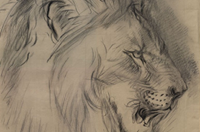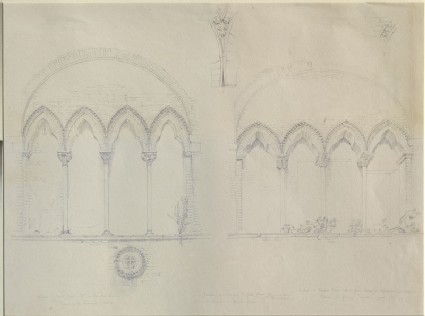Ruskin's Standard & Reference series (1872)
Exemplary works of art. In the catalogue of the Reference series, items marked 'M' are drawings "by my own Hand" (by Ruskin), P are photographs, E engravings and A by Ruskin's Assistant, Arthur Burgess.

Ruskin's Catalogues: 1 object
Show search help- Reference URL
Actions
Windows and Mouldings on the Case dei Guinigi, Lucca John Wharlton Bunney
-
Ruskin text
82 Details of the Palace of Paul Guinigi, at Lucca. (This year, 1872, destroyed by scraping over all its bricks.) -
Curator’s description:
Description
The drawing shows four details from the complex of buildings and towers in Lucca called the Case dei Guinigi. These details are:
On the left: the second first-floor window from the left on the Via Guinigi (formerly Via San Simone) facade, comprising four pointed trefoil-headed lights, the entablature decorated with carved flowers, supported on three slender capitals with elaborate foliate capitals, and two plainer piers on the outside. These are all framed with a shallow rounded arch. The left-hand light, at least, is bricked up. Below the second light from the right is a small round window, protected by metal bars, surrounded by an entablature similar to that above the window-arches. (This is the second window to the right of the corner in Bunney's view of the whole building, no. 83 in the Standard Series.)
Top, centre, labelled '1': a detail of the springing of one of the first-floor window-heads.
On the right: the first second-floor window from the right on the Via Sant' Andrea facade, comprising four pointed trefoil-headed lights, the entablature decorated with carved rounded crosses, supported on three slender columns with foliate capitals, and two plainer piers on the outside. The windows have been reworked, so that rectangular openings can be seen in the three lights to the right, whilst the left-hand light has been bricked up. A row of flowers in pots can be seen over the edge of the window-sill; these identify the window when compared to Bunney's view of the whole building, no. 83 in the Standard Series, where this is the first window to the left of the corner.
Top, right, labelled '2': a detail of the moulding in the entablature from the second-floor window.
On 11 November 1866 Ruskin, concerned that Bunney had been developing bad habits in Florence, wrote to him and asked him to go to Lucca to draw Santa Maria della Rosa and the Guinigi palace. On 13 February, Ruskin again wrote to Bunney, saying that he had received the three drawings he had requested: 'I am entirely delighted with these drawings. They are exactly what I wanted and exquisitely careful, and laboriousy faithful and successfully laborious. You must be in "splendid health" to be able to do anything like them.' The three drawings were placed together in the Reference Series, where they were first catalogued in 1872.
Reviewing Lord Lindsay's "History of Christian Art" in 1847, Ruskin used the palace as an example of 'the truly noble form of domestic Gothic', although it is difficult to reconcile his discussion of arch-forms in the discussion with those shown in this drawing (§ 24 = XII.194-5). Ruskin was also concerned about the building's destruction by having the brickwork cleaned - or, in his words, 'scraped over' (Standard and Reference Series catalogue).
-
Details
- Artist/maker
-
John Wharlton Bunney (1828 - 1882)
- Object type
- drawing
- Material and technique
- graphite on wove paper
- Dimensions
- 526 x 398 mm
- Associated place
-
- Europe › Italy › Toscana (Tuscany) › Lucca › Lucca › Case dei Guinigi › Case dei Guinigi (subject)
- Inscription
- All in graphite.
Recto:
the small detail of mouldings, top centre, is labelled: 1
the small detail of mouldings, top right, is labelled: 2
bottom left corner: 3
lower left: Window on First floor 2nd in Via San Simone | Palace of the Guinigi Lucca.
lower centre: 1. Junction of ornament on first floor seen on a level | with the window. | 2 Ornament on second floor.
lower right: Window on Second floor seen from below on opposite side of Street. | Palace of the Guinigi Lucca. Jany. 67
Verso:
lower right (recent): 15-5-70 unmounted | Ref 82 | Bunney
just to the left, the Ruskin School's stamp
- Provenance
-
Commissioned by John Ruskin in 1866; presented by John Ruskin to the Ruskin Drawing School (University of Oxford), 1875; transferred from the Ruskin Drawing School to the Ashmolean Museum, c.1949.
- No. of items
- 1
- Accession no.
- WA.RS.REF.082
-
Subject terms allocated by curators:
Subjects
-
References in which this object is cited include:
References
Ruskin, John, Catalogue of the Reference Series Including Temporarily the First Section of the Standard Series (London: Smith, Elder, [1872]), cat. Reference no. 82
Ruskin, John, ‘The Ruskin Art Collection at Oxford: Catalogues, Notes and Instructions’, Edward T. Cook and Alexander Wedderburn, eds, The Works of John Ruskin: Library Edition, 39 (London: George Allen, 1903-1912), 21, cat. Reference no. 82
Location
-
- Western Art Print Room
Position in Ruskin’s Collection
Ruskin's Catalogues
-
Ruskin's Standard & Reference series (1872)
82 Details of the Palace of Paul Guinigi, at Lucca. (This year, 1872, destroyed by scraping over all its bricks.)





